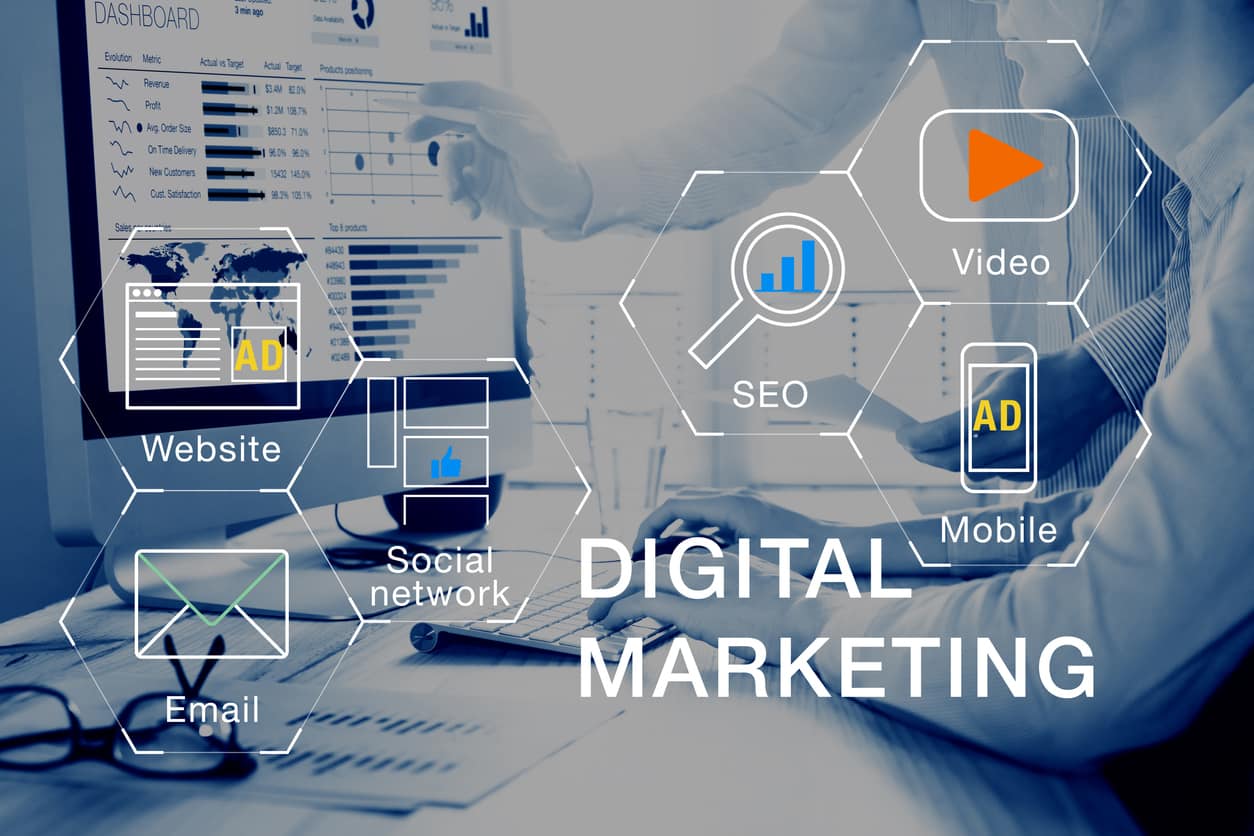In today’s online world you need the right digital marketing tools to succeed. Whether you are a small business owner, a marketer, or just starting out, knowing how to use digital marketing tools effectively can make your work easier, faster and more results-driven.
This post will show you what digital marketing tools are, why they matter, how to pick the right ones, and how to use them step by step so your marketing becomes more effective.
What Are Digital Marketing Tools
Digital marketing tools are software, apps or platforms you use to run, measure and improve your online marketing. These tools help with many tasks such as creating content, managing social media, tracking website traffic, finding keywords, analysing competition and sending email campaigns.
For example, tools like SEMrush and Mailchimp are well known digital marketing tools.
Good digital marketing tools free you from manual work, let you focus on strategy and creativity, and help you measure what works.
Why Effective Use of Digital Marketing Tools Matters
Using digital marketing tools is not enough. You must use them effectively, otherwise they are just software sitting idle. Here are key benefits when you use them well:
- Saves time: Instead of doing everything manually, tools automate tasks like scheduling posts, tracking metrics and organising content.
- Improves accuracy: Good tools show data. You can see how your website performs, which campaign brought sales, what keywords worked.
- Helps scale: When your business grows, you can use more advanced features of these tools.
- Gives competitive edge: Many businesses ignore tools or use them poorly. If you know how to use digital marketing tools effectively, you get ahead.
Because of these reasons, integrating digital marketing tools into your daily work is a smart move.
Categories of Digital Marketing Tools & How to Use Them
Let’s break down the main categories of digital marketing tools and how you can use each one.
1. Analytics & Performance Tools
These tools help you see how your website or campaigns are doing. Example tools: Google Analytics, SEMrush, etc.
You use them to track: visitors, where they come from, what they do, how long they stay, and which pages convert into leads or sales.
2. SEO & Keyword Research Tools
If you want your site to rank in search engines, SEO tools help you find keywords, check backlinks, and analyse competitors. Example: SEMrush, Ahrefs.
You use them to pick the right keywords, optimise pages, and improve search visibility.
3. Social Media Management Tools
These help you schedule posts, manage multiple social platforms, monitor engagement and reply to comments. Example tools: Hootsuite, SocialBee.
You use them to maintain consistent presence online without manually posting every time.
4. Email Marketing & Automation Tools
These tools help you send newsletters, automate follow-up messages, manage subscriber lists and track email performance. Example: Mailchimp.
You use them to convert visitors into leads and leads into customers with minimal manual work.
5. Design & Content Creation Tools
To make attractive visuals, videos and content you use tools like Canva, Adobe Express, or Illustrator. These are part of your digital marketing tools set.
You need good visuals for your social posts, blog graphics, ads, etc.
6. Paid Advertising & Campaign Tools
If you run ads on Google, Facebook, or other platforms, you will use tools to create ads, set budgets, target audiences and measure results. These tools form part of your digital marketing tools toolbox.
7. Landing Page & Conversion Tools
Tools that help you build landing pages, test different versions (A/B testing), capture leads and improve conversions. These help you use your traffic effectively.
Each category addresses a different need. When you combine multiple tools, you build a full system.
How to Choose the Right Digital Marketing Tools
With so many digital marketing tools out there, choosing the right ones can be hard. Here’s how to pick:
- Start with your goal: What do you want to achieve? More visitors? More sales? More social engagement?
- Match tool features to your goal: If your goal is search traffic, pick an SEO tool. If it’s social presence, pick a social media management tool.
- Check budget: Many digital marketing tools have free versions or low-cost plans.
- Ease of use: Tools should be simple enough to use or learn quickly.
- Integrations: Tools that connect with each other make work easier (e.g., analytics connects to website, email tool connects to CRM).
- Scalability: Choose tools you can upgrade as your business grows.
By making thoughtful choices, your use of these digital marketing tools becomes more efficient and effective.
How to Use Digital Marketing Tools Effectively – Step by Step
Now let’s walk through a practical steps you can follow to use digital marketing tools effectively.
Step 1: Set Clear Goals & Metrics
Before you open any tool, set goals like: “Increase organic traffic by 30% in 6 months”, “Grow social media followers by 5,000 in 3 months”, or “Get 200 email subscribers per month”. Then pick metrics to measure: visits, bounce rate, conversion rate.
Your digital marketing tools will report on these metrics, so you know whether you are meeting your goals.
Step 2: Select Your Tool Set
Pick one tool per category to start. For example:
- Analytics: Google Analytics
- SEO: SEMrush or free alternative
- Social media: Hootsuite or Buffer
- Email: Mailchimp
- Design: Canva
Install or sign up, connect them to your website, social accounts, mailing list etc.
Step 3: Collect & Organize Data
Use analytics tools to gather data: which pages are visited, what keywords are used, which social posts get more likes.
Organize the data: build dashboards or simple spreadsheets using your digital marketing tools so you can review at a glance what is working.
Step 4: Create & Publish Content
Use design and content creation tools to make posts, images, videos, blog articles. Use SEO tools to pick keywords, use email tools to plan and send campaigns.
Use your social media management tool to schedule posts in advance. This saves time and keeps your presence consistent.
Step 5: Monitor & Analyse Performance
After publishing content or running campaigns, use your analytics and tools to measure results. Ask: Did traffic go up? Which keyword improved? Which post got more engagement?
Use digital marketing tools to compare data over time. See trends, see drop-offs, see what needs fixing.
Step 6: Optimize & Improve
Based on your tool data, you make changes:
- Update content that is underperforming.
- Change keywords for pages not ranking.
- Adjust campaign targeting for social or ads.
- Re-design visuals if engagement is low.
- Test different subject lines in email tool.
Effective use of digital marketing tools means you don’t just run tasks, you improve them.
Step 7: Scale Up
Once you see what works, you can scale: invest in higher-tier tools, automate more, push paid ads, grow your team. The digital marketing tools you used for testing become your foundation for growth.
Common Mistakes When Using Digital Marketing Tools
Even when you have the tools, many users don’t get results. Here are common mistakes and how to avoid them:
- Using too many tools at once without mastering any (choose fewer and learn them well).
- Not setting goals so tool data has no direction.
- Ignoring tool data—if you don’t look at the reports, you won’t know what to change.
- Neglecting integration—tools that work in isolation waste their power.
- Focusing only on new tools, ignoring basic ones like analytics or email.
- Not updating your processes—tools change, features evolve.
Avoiding these mistakes helps you make your digital marketing tools work harder and smarter.
Real-World Example: How a Small Business Uses Digital Marketing Tools
Imagine you run a small online fashion brand in Nigeria. Here is how you might use digital marketing tools effectively:
- Goal: Get 1,000 website visitors monthly and 50 email subscribers each week.
- You choose tools: Google Analytics (free), SEMrush (free trial), Canva (free plan), Hootsuite (free plan), Mailchimp (free plan).
- Collect data: You use Analytics to track visitors to your product pages. Use SEMrush to find keywords like “affordable Ankara dresses Nigeria”.
- Create content: Use Canva to design Instagram posts and blog graphics. Use keywords in blog articles.
- Publish & promote: Use Hootsuite to schedule posts, send email via Mailchimp to your list.
- Measure: See which blog gets most traffic, which social post gets most likes, which email subject line had highest open rate.
- Improve: Update blog to add better keywords, reschedule posts at better times, refine email.
- Scale: After 3 months you upgrade tool plan, run a paid ad and hire a virtual assistant.
This process shows how digital marketing tools become part of your system and help you grow.
Tips & Best Practices
- Start free or low-cost: Many digital marketing tools offer free plans. Use them first.
- Train yourself: Spend time learning how each tool works. YouTube tutorials, webinars, blogs help.
- Record your workflow: Note down how you use each tool, what tasks you perform daily.
- Keep data clean: Make sure tracking is set up correctly, there are no duplicates or errors.
- Review regularly: Weekly or monthly review sessions help you catch problems early.
- Stay updated: Digital marketing tools change often; new features come.
- Combine tools smartly: Integrations make your life easier (e.g., social posts trigger email, analytics feed into dashboard).
By following these best practices you make your use of digital marketing tools more effective.
Conclusion
Digital marketing tools are not magic pills; they only work when you use them properly. When you pick the right tools, use them in a structured way, measure results, and improve based on data, you will see real benefits. Designing a system where tools support your goals is what makes marketing effective.
If you take the time to learn a few key tools, set up clear processes, analyse your results and scale what works, your business or brand will grow. Use your digital marketing tools as allies, not just software.
Also Read:How to Build a Digital Marketing Website That Converts in 2025

